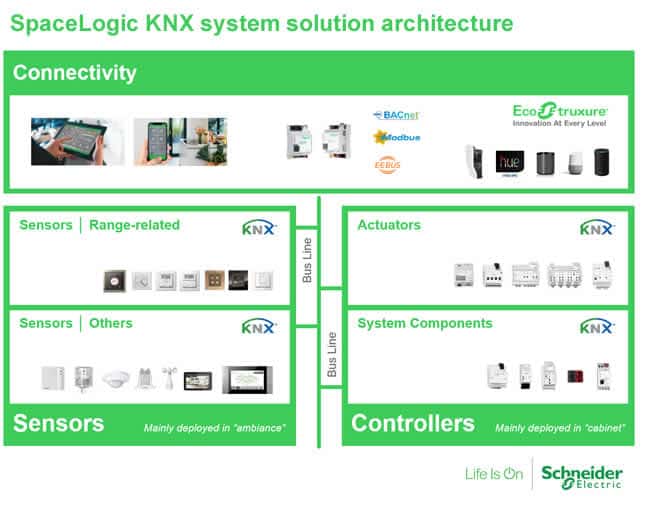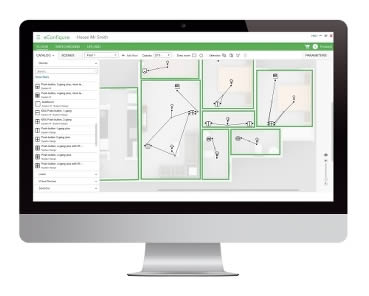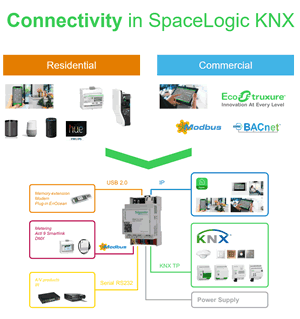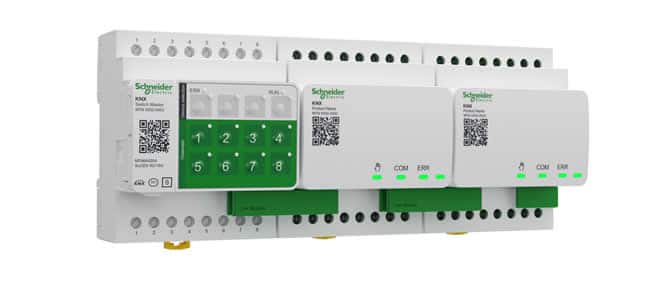The next level of KNX – the integrated SpaceLogic KNX approach
The next level of KNX – the integrated SpaceLogic KNX approach
KNX, the open standard for building and home automation, is entering its fourth decade. In 2020 it was exactly thirty years ago since the EIB (Association), from where the standard originates, was founded.
The KNX Association, as it’s now called, has around 495 KNX members, 500 training centers, and 91,000 installation partners in nearly 170 countries.
One of the reasons for the success of KNX: it is a proven technology with guaranteed interoperability between products and a common development environment. At least as essential for its success are the solutions that are built upon the KNX infrastructure by leading companies.
They take KNX and its benefits into the larger scheme of a connected built environment with solutions enabling installers and integrators to meet changing customer needs.
That’s precisely one of the topics we cover in this interview on KNX and how it progresses in this expanded scope and the age of IoT.

Our interviewees are Dusan Janjic and Howard Jiang. Dusan is globally responsible for the Light & Room Control EcoXpert certification. Howard is Program Manager of Smart Buildings at Schneider Electric, focusing on KNX systems.
They explain the core benefits and the evolving role of KNX on a higher and further-reaching connected level. Moreover, we take a look at how Schneider Electric’s SpaceLogic KNX enables partners to bring the standard and solutions they offer their clients to that next level – and beyond. Schneider Electric is heavily involved in the KNX ecosystem and has been since the foundation of the standard via Merten, a German company it acquired in 2006.
By integrating KNX more seamlessly into several solutions inside and outside of the building, we drastically expanded its possibilities. We enriched the original idea of KNX and brought it to this next level, enabling customers and partners to realize far more, thanks to a much higher degree of integration with ever more environments.
Mục lục bài viết
Enriching the original idea of KNX with a higher level of integration
Gentlemen, thank you for your time. KNX exists for three decades. It’s a well-established standard, but you developed an approach whereby KNX goes further. Why is that?
Howard Jiang: People know the standard, the manufacturers, and the place that KNX has in in-house and in-room automation. Until recently, we’ve been following more or less the same route as other companies in the space. Yet, now we expanded its possibilities and value with SpaceLogic KNX.
Customers and partners today want integrated solutions, and there are ever more solutions that need to be connected as the market evolves.
So, in these times of convergence and the need for smart connected solutions across multiple domains, you need to look at how you can leverage KNX to create meaningful value to customers and partners in a broader context. And that’s precisely what we did.

Howard Jiang
In the traditional, and still very important KNX domains of building and home automation, we seamlessly integrated with newer ecosystems and types of applications leveraging the Internet of Things, including those of third parties and partners. And we expanded KNX into other domains we cover at Schneider Electric with, for instance, energy management, the whole power domain, and newer types of applications.
Dusan Janjic: Ultimately, with KNX, we can bring in a whole field layer of control and with SpaceLogic elevate it into the overall story of Ecostruxure, enabling many additional services, which really is our strength and differentiator.
We can bring it into the power management aspect, the larger scheme of a building, a smart city concept; you name it. Through integration with EcoStruxure and the grid itself, we can even use the lighting control and comfort element in demand response actions across the full energy management of a building.
So, in our approach, KNX is not just about switches and sensors that enable us to manage an internal space nor purely about the in-house or in-room component as we’ve known it for years, and that is obviously still essential. However, we’re really opening up KNX to leverage it within full smart systems, smart buildings, smart grids, and smart communities here, instead of just for a smart room or smart home.
True seamless integration and interoperability for present and future challenges
Before looking at how precisely this integration works and your EcoXpert partners can leverage it, let’s go back to the roots of KNX and see how it is used today with its light & room control and smart home aspects. What’s the Schneider Electric take here? What do you see as the main benefits of KNX, and what sets it apart?
Dusan Janjic: The main benefit of KNX is that, as an open system, it offers seamless interoperability between devices at the room level or the floor level within a building.
Other protocols such as BACnet and LON are also interoperable, but you need to pay attention to what level they really are. With KNX, you are sure that even if you buy a sensor from one manufacturer and a controller from another, you can truly mix and match and create the best system on a local level, a building level, or a home level, and the software development environment is the same. Our EcoXperts (note: EcoXpert is the award-winning channel partner program of Schneider Electric) and other customers can get all these devices from us as well and optimize for the best solutions.
Yet, what differentiates us most is the mentioned seamless integration with EcoStruxure and some other platforms we offer and the way our KNX platform is designed.
As a consequence, we don’t just offer interoperability on the level of devices within a building but also for those high-level integration applications, such as being able to have intelligent demand response, distributed power and energy storage, EV chargers, etc.
Given this integration/interoperability on that higher level, it’s much easier for partners to realize such applications. Then we’re not just talking about having the best building but also the most responsive building that can then be integrated within a smart city context.
The ability to integrate on various levels and build solutions, all the way up from the component level in, for instance, home automation, to the types of high-end solutions with EcoStruxure and other platforms, nowadays inevitably means many Internet of Things standards. The ‘older’ protocols you mentioned remain key and continue to evolve. How does KNX fit in this picture with still too many IoT technology standards and interoperability being vital?
Howard Jiang: Vendors that entered the smart home and building space with IoT solutions more recently are launching initiatives to enable compatibility and interoperability between their standards.
End of 2019, for instance, the Zigbee Alliance of which we’re a member joined forces with Amazon, Apple, and Google to develop an open standard for smart home devices.
It’s a phenomenon we see since the very early days of networks: different players have different standards, and at a certain point, they start collaborating because they know propriety protocols hinder market adoption.
In home automation – and building automation – this idea to have an open standard was already embedded in KNX from the very start, 30 years ago, when a group of manufacturers started Instabus.
Among the founding members of what would become KNX and, for several years, was known as EIB (European Installation Bus), was Merten, later acquired by Schneider Electric. So, we’ve been involved since the early days and still are today given the importance of interoperability and standardization.
The inherent benefits of KNX
What other some of the other inherent benefits of KNX people should know about?
Howard Jiang: Guaranteed interoperability is still the main benefit of KNX. On top of that, there is the fact that KNX is easy to set up with a standard commissioning tool (ETS), the openness to other systems, and the support of multiple applications with traditional ones including lighting, sun shading, HVAC, energy management, AV control, and so forth.
Those four major benefits continue to make KNX very attractive and relevant. And it shows in the market: with close to 500 manufacturers and over 8,000 products, KNX keeps attracting many partners each year.
There is also much innovation happening within the KNX Association that enables existing and new partners to keep nurturing the system and inspiring manufacturers. We’re playing an active role in these evolutions, the KNX roadmap, and, of course, through our highly integrated approach.
Importantly, unlike the other protocols, KNX is also very robust, which translates in recognitions from various standard bodies.
It’s the only worldwide home and building automation standard so far and among others recognized as an international standard by ISO (ISO/IEC 14543-3), as a European standard (CENELEC), as a US standard (ANSI/ASHRAE 135) and as a Chinese standard (GB/T 20965).
For all these reasons and given the fact that KNX keeps expanding into more countries, it has a dominant installation base in the market and leads in several markets. In Germany, for instance, KNX accounts for over 56 percent of the smart home and light commercial market and in China for more than 40 percent of the installed base.

The SpaceLogic KNX platform – expanding the robustness of KNX to the next level
Clear. Can you give us more details about the integrated KNX approach of Schneider Electric and how it works?
Howard Jiang: Sure. So, as you know, KNX is a bus system, using a standard data cable for a multitude of applications, which, as said, is one of its inherent benefits.
Our SpaceLogic KNX platform that is designed to elevate KNX to the next level is based on the classic and robust KNX system, which consists of two essential groups of KNX components: the sensors and the controllers, including actuators. These are connected through the traditional KNX bus system.
Where we made it really different is the connectivity level that sits on top of it, where we opened up a vast range of possibilities thanks to the mentioned integrations with non-KNX systems and our EcoStruxure architecture.
The connectivity part still connects with the various systems/components through KNX, but they are equipped with additional interfaces to the external, non-KNX environment. And this is precisely what opens up these enormous possibilities while keeping the essential idea of the robustness and reliability of KNX itself.
There are quite a few of those integrations. I see BACnet, Modbus, EEBus, the combination with EcoStruxure, and other applications but, also among others, Philips Hue. Earlier, you mentioned an open standard initiative with the Zigbee Alliance coming. Is the plan to keep expanding these connectivity options and include new ones such as this open standard?
Howard Jiang: Indeed. Connectivity is a true differentiator for us, and we’re closely watching what happens and working with several partners. In the case of that open standard, we already have a team involved.
And other integrations already exist, both in the residential and commercial building space. There is, for example, our Wiser portfolio, and we work with different vendors and ecosystems, whereby we expand use cases beyond KNX.
Our multi-protocol device is connected with our KNX system and can connect with non-KNX components via interfaces such as the ones you mentioned and IP, USB, etc. We call it our Swiss knife. In the residential space, you can, for instance, extend KNX control to smart speakers, smart lighting, and even e-mobility for smart energy management. In the commercial space, the device, among others, serves as a bridge to connect SpaceLogic KNX products with EcoStruxure Building so that customers can have all Schneider Electric products managed by one solution.
And we will indeed continue to enrich the features to elevate the value for customers, both in residential and commercial spaces.
OK. What else makes the SpaceLogic KNX platform different besides the connectivity that enables to expand the usage of KNX in more use cases and domains such as the ones mentioned in the beginning?

The eConfigure KNX graphical software makes it easier for Schneider Electric partners to set up KNX systems
Howard Jiang: We wanted to make it easy for our partners to set up or commission the systems. Therefore we developed an intuitive software tool, eConfigure, which they can use instead of the standard KNX ETS software if they prefer.
Another important aspect I want to emphasize is cybersecurity, which is a top priority for us as Schneider Electric stands for reliability. It’s part of our DNA and today inevitably includes cybersecurity and cyber resilience.
Everything needs to pass through the threat tests we defined and is compliant with the Schneider Electric cybersecurity approach, which is one of the strictest in the market. We also are compliant with KNX IP Secure, which meets the highest security requirements according to the encryption standard AES128. With this end-to-end cybersecurity approach, we ensure that systems run with the least possible risk in an end-to-end way.
As far as concerns the classic KNX components which we offer, the sensors and controllers, we differentiate ourselves with a very complete assortment of sensors and controllers, with reliability again being key, along with flexibility and simplicity, making it easy for partners to set up everything.
Yet, the essential differentiator remains connectivity with ample interfaces and the possibility to realize integrations and fulfill applications, both in the residential and commercial space, as just mentioned.
How SpaceLogic KNX meets evolving customer demands – engaging spaces
You mentioned some of the benefits of KNX in general and SpaceLogic KNX in particular. How do they translate into the needs of end clients such as occupants and workers in commercial and residential buildings? What do people value here according to you that SpaceLogic KNX can offer them?
Howard Jiang: For customers, I see three main areas where SpaceLogic KNX helps realize what customers value. It enables us to create spaces that are 1) more engaging, 2) hyper-efficient, and 3) truly sustainable. Allow me to zoom in on all three aspects.
More engaging spaces enable people to interact with the environment. As a consequence, they can better enjoy the space, feel more comfortable, be more productive, and adapt the space to their needs in an increasingly personalized way.
I think that many people felt this need for more engaging spaces as they had to spend more time at home because of the COVID pandemic, but also as many worked more from home. So, while engaging spaces might have meant slightly different things, depending on whether it’s a commercial or residential building, to some extent, they increasingly overlap. When you work at home, you want to be productive as well.
Now, how precisely does SpaceLogic KNX helps create more engaging spaces? You can distinguish different steps here on top of the essence of KNX as such.
KNX previously only was for lighting control: dimming down the light, pulling up blinds, you name it. The first step that came on top of this essential promise of KNX was indoor climate control with sensors for air quality, humidity, temperature, etc. and controllers to control the valve, control the fan coil, turn up or down the temperature, freshen up the air, and so on. Along with lighting control, this dimension of climate control is still mainly about KNX and comfort, as many know it.
In a second step, we wanted to make the experience of tenants and workers more personalized and unique, enabling them more choice and control. And here there are three elements:
- The user interface where we wanted to offer a more versatile choice so that people have more options than just pushing a button in their call to, let’s say, control the lights or shutter. They can use a smart panel, leverage voice control to interact with their space; in other words: more ways to interact/engage with their space.
- The design element is a second area where we offered a more versatile choice. Design aesthetics matter for most people, so it’s clear that here as well, they want to personalize their spaces.
- The ability to incorporate other systems that make the experience more personal and where the interoperability is important as well again. If people see an exciting product from Philips Hue or want a high-quality professional Hi-Fi system from ReVox, we can integrate it with the KNX control system, so they don’t have to run separate systems.
With the third element for personalization, third-party integration, we’re again at the key benefit of SpaceLogic KNX since it’s clear that the landscape of solutions and applications is a never-ending one and keeps evolving. You can think about EcoStruxure but also about our Wiser offer that has ample smart home solutions and integrates with the home speakers from the well-known brands.
Last but not least, in this fourth step, which is making sure that we keep evolving and leverage our connectivity to stay in sync with what customers want and the innovations in the market. These include the evolutions in the more classic technologies themselves. There are the evolutions in KNX but also in, for instance, the DALI lighting standards. In other words: an ongoing story to create more productive and comfortable spaces that are engaging and continue to be as the market evolves.
Efficiency and sustainability with SpaceLogic KNX
Howard Jiang: Next, customers want their buildings to be hyper-efficient. To realize this higher level of efficiency, we integrate KNX across multiple dimensions.
The first one is energy management. KNX is usually for room automation. As an expert in both automation and energy management, we designed SpaceLogic KNX to be a bridge between them, for instance, to deal with solar panels and do EV charging. This way, customers can manage energy consumption and demand response with the automation system instead of needing a separate system to do so.
Secondly, there’s scalability. SpaceLogic KNX is scalable as we can integrate connected devices into our cloud-based solution. In a commercial building, a customer can, for instance, have a room solution and, later, decide to manage the entire building. Then we can add a gateway to the BACnet of the building management system and provide the full service through EcoStruxure with all the additional benefits on the level of energy efficiency, real-time insights, and predictive maintenance.
Thirdly, SpaceLogic KNX extends what our partners and we can offer to customers beyond the products and the design and build phase, making it easier to operate and maintain as well. One aspect of this is the fact that the device is upgradable, and our partners can go back to customers and help them to update. Secondly, the offer also comes with new digital features. It is ready for building information modeling (BIM) and supported by Schneider Electric Exchange. With BIM, architects and other stakeholders can help the customer and manage the project from the beginning, design, all the way to the maintenance phase.
And, finally, we can help customers who have realized a project on one site and want to do the same on another. Whether it’s in the same country or somewhere else across the globe: with our vast network of partners in over 50 countries, we can help them realize this fast. An example is a large retailer for whom we’ve set up the full lighting control, including the shopping area and the parking space. We helped them duplicate this with or support and partners, enabling a high level of efficiency here as well.
The third benefit for customers is sustainability. It’s a customer need that has come back in a range of interviews we previously did, from retail facilities to smart buildings and real estate, hotels, smart homes, healthcare facilities, everywhere really. How do KNX and SpaceLogic KNX help here?
Howard Jiang: Indeed. Looking at it from a KNX solution perspective, sustainability, is partially about energy efficiency but also goes beyond it to realize true sustainability.
For starters, home automation, energy-saving, efficiency, and KNX are already related. Everyone is doing that, but we go a step further, and the SpaceLogic KNX smart features help achieve new levels of energy efficiency. On top of the enhanced features which our products have to provide more energy savings, as mentioned, they are also upgradable, which isn’t the case for most devices in the field from others. Secondly, there is again the fact that it’s scalable whereby, once a company has set up a project on one site and then replicates on another one, in the end, the facility manager will be able to manage these different sites such as stores.
We’re also actively involved in the KNX Association to make the KNX technology itself more sustainable and contribute our knowledge in discussions on new specifications and the future roadmap with, for instance, KNX IoT and KNX Secure, thus helping the whole ecosystem advance.
We also strongly believe that sustainability means breaking silos. So, we work with some companies that aren’t KNX players. We reach out to them, and with our connectivity possibilities, help them integrate their solutions and offer a total offering to their clients without them having to invest in a system. Two examples are Italian lighting company Cuzzini, very present in fashion shops, and German lighting company SLV. They don’t have a control system, so we helped them. Cuzzini’s high-end lighting can now also be controlled, dimmed, set up for different colors and tones for different seasons, you name it.
By working together with a growing number of manufactures from other domains to expand use cases in this way, customers do not need to waste their energy and money to bring different solutions together. Other manufacturers, we work with include somfy and those mentioned earlier, such as ReVox.
EcoXpert and KNX – partner benefits and programs
Talking about partnerships, benefits for end customers, and your partners serving them often go hand in hand. The fact that partners can help them beyond the build and design phase is just one example you mentioned. What are the benefits and value points of your KNX approach for EcoXpert partners?

SpaceLogic KNX extends connectivity in residential and commercial with the help of a a multi-protocol gateway
Dusan Janjic: Well, as you know, our EcoXperts are vital, and they are the ones that make it happen. As mentioned earlier, we developed some tools that make it easier for them to commission solutions. Yet, in general, we want to make it easy for them on all possible levels. Simplicity is a keyword here and even our promise.
Simplicity first means that we created all kinds of partner-friendly assets, making it easy to rapidly select the products and solutions that suit their needs and those of their customers best.
Simplicity also means flexibility since customer demand and the market constantly evolve. So, if customers decide to go to the next level with an automation platform or integrate other services, it must be easy for partners to cope with such dynamic needs. That’s possible, thanks to the modular design of our products.
Finally, simplicity also means that the solutions they offer to their customers must be future-proof so they can leave the project with “peace-of-mind” and efficiently deal with what comes after the build and design phase indeed, mainly maintenance. The fact that our solution/productions are traceable and updatable adds to that.
Benefits for partners and customers indeed often overlap, also from the value proposition and thus selling perspective. Here it’s important that, on top of being recognized as a leader in medium voltage, Schneider Electric also continues to climb up the ladder of leaders in building automation according to analysts, and SpaceLogic KNX inherits that recognition.
I also need to bring back reliability in the picture as reliability and product quality are differentiators. Our commitment to cybersecurity, whereby we are part of the Global Cybersecurity Alliance and the fact that the SpaceLogic KNX offer has the highest available data encryption standards and passes stringent internal stress tests, is again part of this. From a product quality perspective, it’s worth mentioning that most of our offer is designed and tested in Germany and manufactured in Europe.
From a more strategic and business partnership perspective, we offer all tools and assets to help EcoXperts grow their business, regardless of the experience they have with KNX.
- KNX novices can become qualified by signing up for our training program to differentiate themselves further and grow their capabilities.
- KNX adopters can continue to enrich their knowledge by engaging with the developers and front-line experts in our Schneider Electric Exchange community, which enables them to gain insights and learn best practices.
- For KNX masters, the Exchange marketplace offers the possibility to explore more business opportunities and even sell their solutions directly.
Growing the KNX ecosystem with Exchange and the SpaceLogic KNX road(map) ahead
Since its launch in 2019, Schneider Electric Exchange has come back in each interview we conducted on the several certifications and specializations of EcoXpert. It’s clear that Exchange, as a community and a marketplace, has become instrumental, not just for EcoXperts. You just explained its role for EcoXperts. Earlier in the interview, you mentioned how you work with third-party solution providers. Does Exchange play a role here too, and are other manufacturers welcome to join?
Dusan Janjic: Absolutely. Exchange is even more than that, and it is the platform of choice for our KNX ecosystem, including potential future partners, as well.
First, Exchange for us is a way to bring in our partners and dedicated service providers. They are the best delivery mechanism of our solutions in terms of assuring reliability and in ensuring interoperability as they can bring in more than just the mechanics’ piece of the full KNX picture.
On top of enabling partners to offer their services, Exchange is definitely also a way to develop partnerships with other manufacturers or product/service providers who can offer their services but also potential jobs to our partners.
Moreover, we encourage manufacturers and companies such as Fujitsu, Somfy, etc. to use the platform to promote their own solutions, integrated with ours, to our networks and customers who registered.

Ecosystems and integrations, it does remain key in everything you do. To wrap up this interview, a final question on the SpaceLogic KNX roadmap. We could have a look at it, and it does look impressive for years to come. Is there anything partners and customers can already know about what’s coming?
Howard Jiang: There is indeed a lot ahead, on the level of controllers, sensors, and, how else could it be the expansion of connectivity possibilities.
One of the novelties for 2020 is the nascent launch of the SpaceLogic KNX actuators, our new actuator range for light & room control that brings simplicity and flexibility of deployment to projects.
As a matter of fact, it has already been awarded an iF Design Award 2020, another good reason for partners to join us on the SpaceLogic KNX journey ahead.
Gentlemen, thank you for the insights!
Disclosure: this is a sponsored interview in the scope of the commercial collaboration between i-SCOOP and Schneider Electric, containing sponsored links to solutions and the EcoXpert partner program of Schneider Electric.











